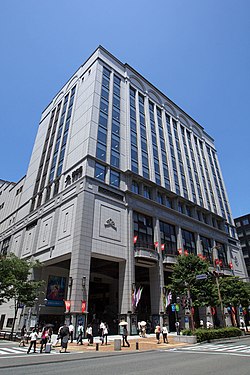Hakata-za
 | |
 | |
| Address | 2-1 Shimokawabata-machi Hakata-ku Fukuoka |
|---|---|
| Coordinates | 33°35′45″N 130°24′23″E / 33.595703°N 130.406477°E |
| Owner | Hakata-za Corporation |
| Type | Kabuki theater |
| Capacity | 1,454 |
| Opened | 1999 |
| Website | |
| Official website | |
The Hakata-za Theatre (
Overview
[edit]The Hakata-za is a multipurpose theater that can be used in all theater genres, such as kabuki, musicals, and mainstream commercial plays (
The Hakata-za stage design concept is "Super Kabuki", a term coined by Ennosuke Ichikawa III in 1986. Stage features such as rotating stages, hanamichi, and orchestra pit can be set up depending on the performance's needs. With the intention of performing Miss Saigon in the original production version, the stage area can accommodate a full-scale helicopter, which is the centerpiece of that production (stage sleeves and depth are about 1.5 times the audience seat area). Wire-flying equipment are also installed in the ceiling.
During the Kabuki performance in June every year, the kabuki actors go on a ceremonial boat ride on the Hakata River, which runs next to the Hakata-za. The theater is open to the public every December. The Hakata Odori, a dance performance by geishas from the Hakata Kenban traditional arts association, is also performed here every year.
The Hakata-za is the first multi-day kabuki performance venue in Hakata since the closed Daihaku Theater. It is actually the second venue to use the name Hakata-za, as the first Hakata-za was opened by Otojirō Kawakami and his troupe in Chiyo, Hakata Ward in 1910.
Curtain seats are available depending on the performance.
References
[edit]External links
[edit]
